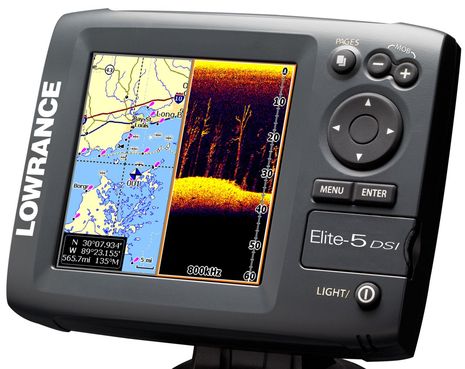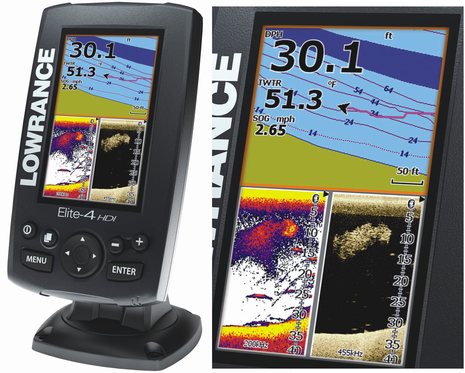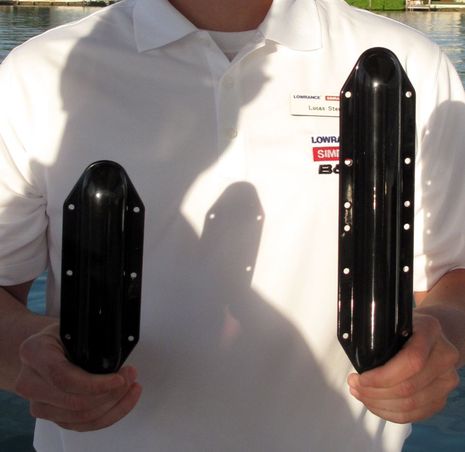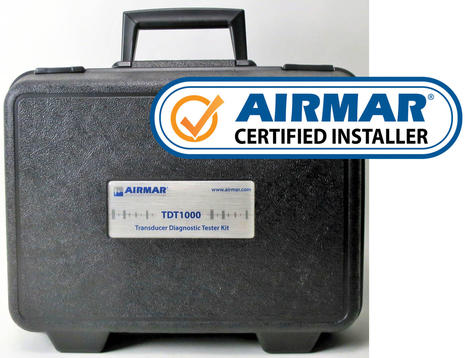Lowrance DSI , & Navionics goes MicroSD (Raymarine included)
Last week Lowrance announced the Elite-5 DSI and some related fishfinder/plotters, and while they’re unabashedly aimed at freshwater fishermen, there’s at least two things of interest to others. DSI stands for DownScan Imaging, which seems to mean that Lowrance has isolated the high resolution down-looking portion of StructureScan into an even more inexpensive form. That means a transducer that can ping at 455 or 800 kHz, trading detail for depth and breadth. Aren’t lots of non-fishing boaters — like gunkholers and/or curious monkeys like me — also interested in detailed bottom imagery, even if it’s only to 100 feet or so? That’s why I installed StructureScan on Gizmo even though the thru-hull transducer wasn’t ready yet, and I can’t wait to seriously experiment with it (soon!). The new Lowrance plotters will also be the first I know of to exclusively use MicroSD chart cards…
The move from regular SD cards to the micro size is no surprise, but I didn’t realize that Navionics is already doing it, as indicated on its card catalog pages. They very likely come with an adapter to fit regular size SD slots, so the transition may be pleasantly hard to notice. But learning that Raymarine is also going to support MicroSD cards may be a very pleasant surprise for folks who may want to swap to Ray from an SD MFD, or vice versa, or want to carry an SD plotter as a backup to a Ray machine designed for CF cards.
I’m not sure when the Raymarine CF-to-MicroSD adapter, and the needed software updates, will be available, or what it will cost, but according to this help page, all the C, E, and G series will be supported, and models that aren’t, like the early A’s, will get an adapter from Navionics. Given that Garmin has been shipping charts on MicroSD cards for a while, are we moving to one standard card size for use in all MFDs and PCs? Wouldn’t that be nice?
PS. Raymarine will include the CF to MicroSD card adapter with MFDs starting in September, and the charge to existing MFD owners will be $30.















A reader pointed out this neat gizmo that can gang 4 MicroSD cards into one CF holder using Raid 0…
http://dvice.com/archives/2009/06/compactflash-ad.php
But I think the Raymarine link is pretty clear that only their CF-to-MicroSD adapter is going to work in their MFDs.
This kind of proprietary nonsense is typical of the plotter makers. What possible rationale could there be for having a custom adapter? You can’t tell me the thing in the photo is IP66-rated!
Also, I am curious about the tiny text on the CF/SD adapter that reads: “Do not use standard high street adaptors for cartography.” Do they mean High Street in London? I never knew it as a center for electronical widgets…
You’re off base on this one, Adam, and I should have realized what was going on when I wrote the entry above. The Raymarine CF to MicroSD adapter, and Navionics’ own version, contains a special circuit that works with the copy protection on the card. Its the same deal as the Navionics multi-card reader needed to see a card from a PC:
https://panbo.com/archives/2006/03/navionics_card_reader_a_windows_gotcha.html
If you want to complain about copy protection, that’s another matter, and you should first speak with all the cruisers still using cracked copies of a C-Map’s worldwide CM93 commercial chart portfolio CD. That theft did some damage to C-Map and the hydrographic offices they pay license fees to, and it made all the chart vendors very, very careful. An interesting discussion on this, including some great examples of the twisted logic some use to rationalize a serious copyright violation is here:
http://www.cruisersforum.com/forums/f121/cm93-international-charts-26656.html
By the way, I found out late today that Raymarine will include the CF to MicroSD card adapter with MFDs starting in September, and the charge to existing owners will be $30.
The Furuno and Maxsea MAPMEDIA Charts (www.mapmedia.com) have always supported ANY media desired by the customer, including fast Internet Download, DVD RW, and any SD format. Even the newly available CMAP/Jeppesen Charts can be loaded onto any media as well.
The only problem I have had is that a micro SD Card flew off the dash and blew overboard before I could catch it last year!!! They are simply quite small to deal with on the water. Luckily with NN3D, it was only an $14 (4G byte) loss as opposed to losing a $300 Encrypted Micro SD Card and I burned another new one with my PC right there.
This is the reason why Furuno/Maxsea switched from encrypted hardware protection to software protection. Any customer can freely update/replace/backup his cartography from anywhere in the planet without having to ship and receive a new encrypted memory chip. If someone steals the chart, no problem. If someone steals the display, they will be outed when/if they ever try to buy another chart.
The small size of the Micro SD is good in a cell phone but, in a marine environment, I recommend the regular SD Cards. Especially with the older customers.
Also, with the pending software revision for Navnet 3D, SD/Micro SD Cards of up to 32G Bytes will be supported!! That will allow up to 16 of the Free High Res Arial Photos to be loaded onto one of the two SD Card Slots in any Navnet 3D MFD.
Furuno Tech
One big plus in this is getting away from the CF card in Raymarine with it’s many pins and “too easy to install the wrong way”keying.
we had a few customers with Raymarine C and E series who bent or broke the pins in the CF card reader.and messed up the CF card itself..not a cheap repair.
The advantages of encrypting the software instead of using hardware control are great for the customer as noted by Furuno tech. We all have deep prejudices (except perhaps Ben) when it comes to the electronics manufacturers based on interfaces, features, and of course our personal experiences. Raymarine has left me cold ever since I bought a total crap fishfinder of theirs 15 years ago and this is yet another example of customer-unfriendly design and support.
Can Furuno Tech share any more about the next NavNet 3D software update? Maybe some of the little annoyances like not supporting fuel rate display for two engines will get fixed? Or perhaps it will be possible to import waypoints and routes incrementally without overwriting and deleting the ones already on the machine?
Geez, Quitsa, you’re still mad at Raymarine for a fishfinder designed at least 15 years ago, when it was a division of Raytheon? And how could Ray have done better with this card adapter given that it has to be custom built hardware to read a Navionics card, by Navionics design?
I do think Furuno Tech makes some great points about their style of copy protection, but also wonder if they have an advantage given that only Furuno and MaxSea can read the MapMedia format. I’m also glad to hear they’re going to support larger SD cards. Updating lots of chart and data files on my test MFD12 was a pain using just 2g cards.
Furuno Tech, how about also making the file names a bit more distinctive. It may be my age, or feeble multitasking skills, but I had a hard time keeping track of what I’d deleted from the MFD, downloaded, upzipped and moved to a card, updated on the MFD, etc., and I used a check list! And how about a screen capture feature in the new NN3D release?…please, please.
Perhaps I should have said “irrational prejudice” in my case from that nasty old fishfinder. Having the experience of using encrypted hardware and dedicated card readers from when I had a Simrad CX44 that used C-Map cards, I do think that the software based encryptin is much more customer-friendly. Furuno maks available C-Map and Navionics charts now for NavNet 3D that are downloaded and not linked to encrypted cards so I don’t see why Raymarine could not have followed suit. Perhaps it is a backwards compatability issue of some sort.
I favor “irrational exuberance” myself 😉
Again, I agree that Furuno’s encryption method is friendlier, but let’s be careful not to compare apples to oranges. The C-Map and Navionics charts from MapMedia just use those company’s core data, and won’t work anywhere else but NN3D and MaxSea TZ. The software encryption is all in house. By contrast, once we work through this MicroSD transition, you’ll be able to use the same Navionics card in MFDs from Simrad, Lowrance, & Raymarine plus with several charting and planning programs via the special card reader (and most of the time you’ll get all the extra features). Navionics is also putting much of their data on Apple and Android app phones, with their own software and others. So I’d guess the SDK for viewing Navionics data is much easier for a hacker to get his hands on, which may account for the hardware encryption.
On a related subject, Garmin recently made it possible to download new or updated charts, but I believe they can only be registered for use with one MFD. I dare say that unfortunate limitation is another precaution against copyright violations. On the other hand, Garmin figured out a way to let users copy embedded charts off an MFD and use them in the planning software HomePort.
Head’s up on the Raymarine CF-to-SD chart card adapter:
http://goo.gl/n2mcN
It doesn’t yet work with E Wide and C Wide MFDs, though Ray is working “feverishly” on an update that will work, and Navionics is still stocking CF cards.